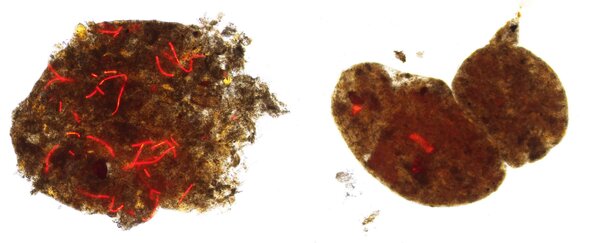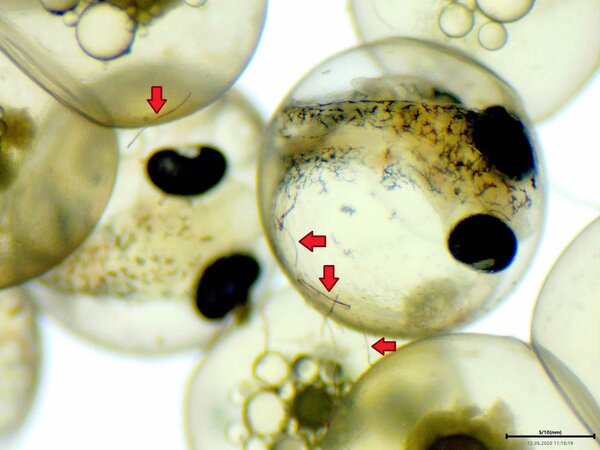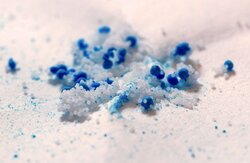Expertise
Microplastics: less harmful to fish than expected
Jörn Scharsack and Marko Freese (Wissenschaft erleben 2022/1)
Microplastics accumulate in the marine environment due to their longevity. Micro plastics enter food webs and are a potential hazard to marine organisms. We have investigated in the North Sea and the Baltic Sea to what extent fish ingest microplastics and tested in the laboratory whether fish are harmed by microplastic fibres.
The pollution of our marine environment with plastic waste is a multi-faceted problem. Plastics are generally long-lived and degrade slowly in the ocean. However, they become porous due to UV irradiation and biofouling and are then broken down by mechanical action. This creates microplastics, which decompose only slowly. However, microplastics can also enter the oceans directly, e.g. via the air or with insufficiently treated wastewater. The form of microplastic particles currently found in greatest numbers in the environment are microscopic fibres that enter the environment during the production and washing of textiles containing plastic fibres.
Their effects on the marine environment are as varied as the plastic waste. Again and again, pictures of seabirds and other marine animals that have become entangled in plastic waste or have swallowed plastic waste and perished helplessly, cause a stir. In addition, there is the question of whether smaller plastic particles could enter the food chain and end up on consumers' plates.

How much microplastic is in the fish?
At the Thünen Institute, possible contamination of fish by plastic waste was therefore investigated in more detail. In a project funded by the BMEL (PlasM), research was conducted into how much microplastic is actually present in wild fish. For this purpose, fish, in particular dab, a flatfish species, were sampled in the North Sea and Baltic Sea during routine fishing. Samples were extracted from the digestive tracts of the fish and analysed for plastic residues using spectrometry. In fact, microplastic particles (mostly "PP", i.e. polypropylene) could be detected in the digestive tracts of the fish. However, typical findings showed less than 10 microplastic particles per fish.
These studies prove that fish ingest microplastics in their marine environment. However, the relatively low number of microplastic particles per fish suggests that microplastics do not accumulate in the digestive tract of fish and that the particles are excreted.
To check this more closely, fish feed was supplemented with microplastic fibres in a laboratory experiment and fed to three-spined sticklebacks. The microplastic fibres were mixed into the feed in relatively low concentrations that were close to the environment, but also in very high concentrations. The aim was to test whether the growth or health of the fish could be affected if the pollution of the oceans with microplastics continues to increase. For comparison, feed with added natural fibres (cotton) and feed without any added fibres was also fed.

No effects on health and larval development
After nine weeks of feeding, the fish were thoroughly examined. The internal organs were weighed and inspected for possible pathological changes. In addition, immune cells were taken from the fish to detect possible inflammatory reactions in the intestine. Interestingly, no differences were found in any of the examinations carried out, regardless of whether feed with little or a lot of microplastic fibres, with natural fibres or without added fibres was used. Microscopic faecal examinations showed that both the microplastic fibres and the cotton fibres passed through the fish gut and were excreted with the faeces (Fig. 1). The lack of effects on the growth and health of the fish studied indicates that the fish were not affected by the microplastic fibres used here in the feed.
Microplastics could affect fish not only through ingestion with food, but also through their presence in the water, i.e. from the outside. Particularly sensitive biological processes such as the fertilisation of fish eggs and the development of embryos in the eggs could be affected. This was investigated in another experiment with three-spined sticklebacks. Eggs were stripped from females ready to spawn and then mixed with sperm. Fertilisation then takes place immediately in the water and the eggs begin to develop. After a few days, the fish embryos can be seen in the eggs (eye spots, Fig.2) and after a few more days the fish larvae hatch.
In the experiment, microplastic fibres were already added to the water during fertilisation of the eggs and the development was observed until the early larval stage after hatching. This experiment also showed no negative effects. Fertilisation and hatching rates were equally high, even when microplastic fibres adhered to the egg shells (Fig. 2). Measurements of the heart rate of the newly hatched larvae also showed no evidence of effects of the fibres.
In a follow-up study, the Institute examined the muscle tissue of sticklebacks in fillets that had previously been fed microplastic particles. A transfer of the particles into the fillet could not be proven. This is in line with numerous other studies that come to similar conclusions. Overall, the studies found no evidence that the health of fish or their edible portion is affected by microplastic particles in the concentrations currently present in the sea.
Service zum Download
- Wissenschaft erleben 2022/1The article on page 6/7 (in German)
The original article in "Science of the Total Environment" (2022): Less impact than suspected: Dietary exposure of three-spined sticklebacks to microplastic fibers does not affect their body condition and immune parameters.
DOI: 10.1016/j.scitotenv.2022.153077







